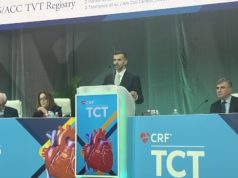
Between 2000 and 2014, in the USA, the percentage of patients with acute myocardial infarction cardiogenic shock (AMI-CS) who developed multiple organ failure increased from 15.7% to 45.5%. Furthermore, while use of angiography and percutaneous coronary intervention (PCI) in AMI-CS patients has increased over this time period, the use of these procedures in patients with AMI-CS and multiple (or single) organ failure has remained low.
Saraschandra Vallabhajosyula (Department of Cardiovascular Medicine, Mayo Clinic, Rochester, USA) and colleagues write in the Journal of the American College of Cardiology that only “a small incremental benefit” has been seen in the AMI-CS population in recent years despite shorter door-to-balloon times and greater use of coronary angiography. They speculate the lack of a greater mortality benefit may relate to the proposed “haemo-metabolic” model for the evolution of AMI-CS “wherein the initial haemodynamic insult subsequently evolves into a metabolic insult, resulting in persistent hypoperfusion and multiorgan failure”. Vallabhajosyula et al note “there are limited data on the burden of multiorgan failure in AMI-CS in modern practice”. “We hypothesised that patients with AMI-CS have evolved into a more a complex population with greater organ failure and that multiorgan failure would be associated with higher in-hospital mortality,” the authors add.
Using data from the National Impatient Sample, Vallabhajosyula et al identified more than 9 million patients who had been admitted to a US hospital with AMI between 2000 and 2014. Of these, 444,253 (4.6%) also CS. Of those with AMI-CS, 64.3% had non-cardiac organ failure and 31.9% had multiple organ failure. The authors observe: “There was a steady increase in multiple organ failure during the study period (15.7% to 2000 to 45.5% in 2014) with a concomitant decline in admissions with single-organ or non-organ failure.” They add that the increase in multiple organ failure “can be explained by the increase in overall comorbidity and acuity of patients present with AMI”. “Due to the rapid improvement in care from ischaemic heart disease due to primary prevention and aggressive revascularisation, it is possible that the spectrum of AMI-CS patients presenting to hospital has systematically shifted during this study period,” they explain.
Vallabhajosyula et al also found that patients with organ failure less frequently underwent angiography and/or PCI than those without organ failure, and the reasons for this were less clear than those for why there has been an increase in the prevalence of multiorgan failure. They comment: “It is important to note that there is no reliable way to assess the timing of angiography with respect to organ failure in this database, and hence organ failure could both have been a barrier to angiography or a consequence of the lack of revascularisation. The bidirectional relationship between organ failure and revascularisation highlights the need for a multidisciplinary approach to decision-making in these patients to improve clinical outcomes”.
As to be expected, in-hospital mortality was increased in patients with organ failure—it was 1.3 and 2.2 higher, respectively, in patients with single and multiple organ failure—compared with those without organ failure. Furthermore, overall in-hospital mortality for AMI-CS remained relatively stable since 2008 despite a steady decline in previous years. Commenting that the prevalence of multiorgan failure started to increase around 2008, Vallabhajosyula et al state: “Taken together, these findings might suggest that any mortality benefit derived from early revascularisation might be offset by multiorgan failure in AMI-CS”. However, they add that their data needs to be interpretation with caution and further evaluation in “carefully designed prospective studies” is required.
Concluding, the authors write: “Dedicated clinical research into pathophysiology and disease-specific factors in AMI-CS is warranted to prevent and treat multiorgan failure in an attempt to improve clinical care and outcomes.”
Vallabhajosyula told Cardiovascular News: “In my opinion, PCI is still the cornerstone of AMI-CS management. There are emerging robust data on the role of multidisciplinary ‘shock teams’ and ‘shock centres’ for the dedicated care of patients with AMI-CS. It is crucial for specialists from interventional cardiology, critical care cardiology, heart failure and cardiovascular surgery to work together with a common aim to decrease the incidence of organ failure and improve the outcomes of this population. There are new and exciting data on the use of temporary mechanical circulatory support in this population that need to be evaluated carefully in a prospective fashion.”










